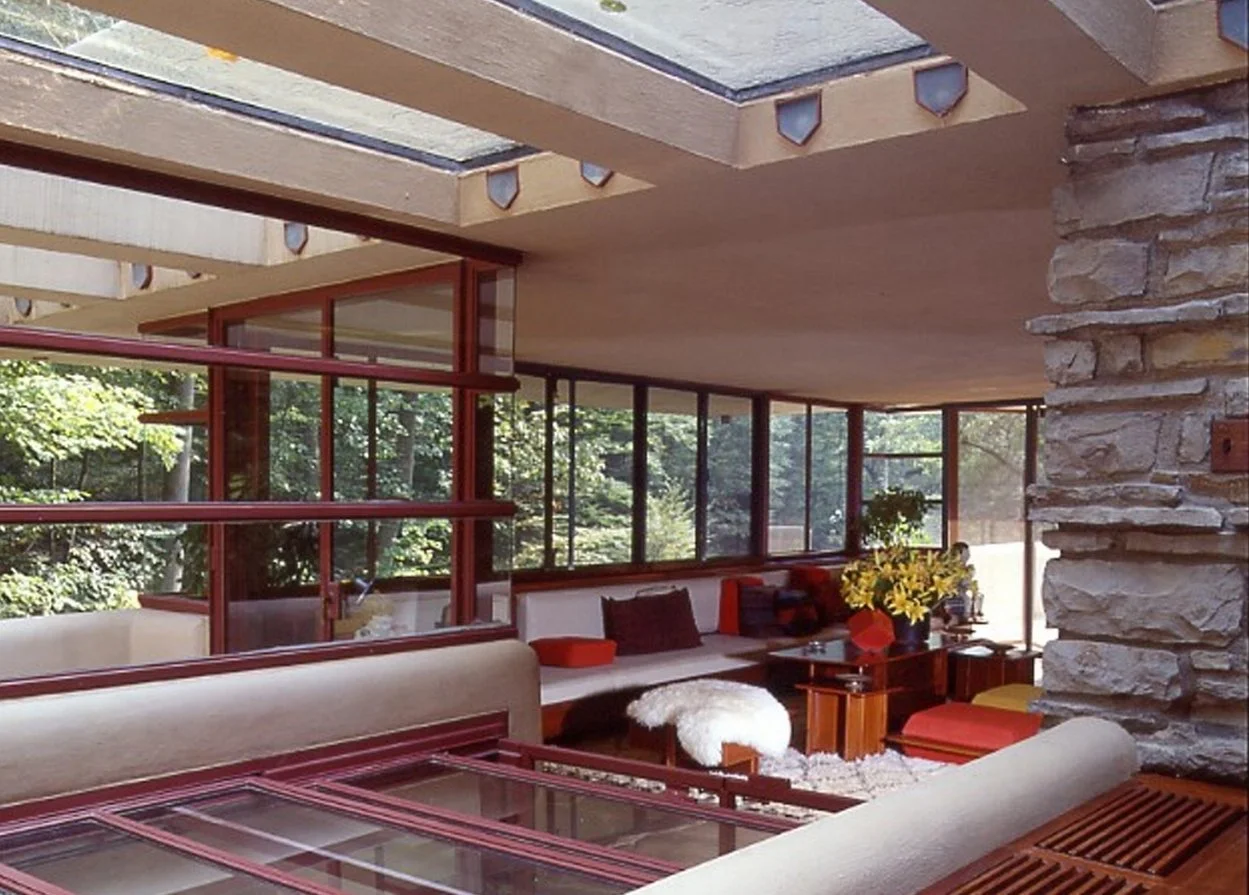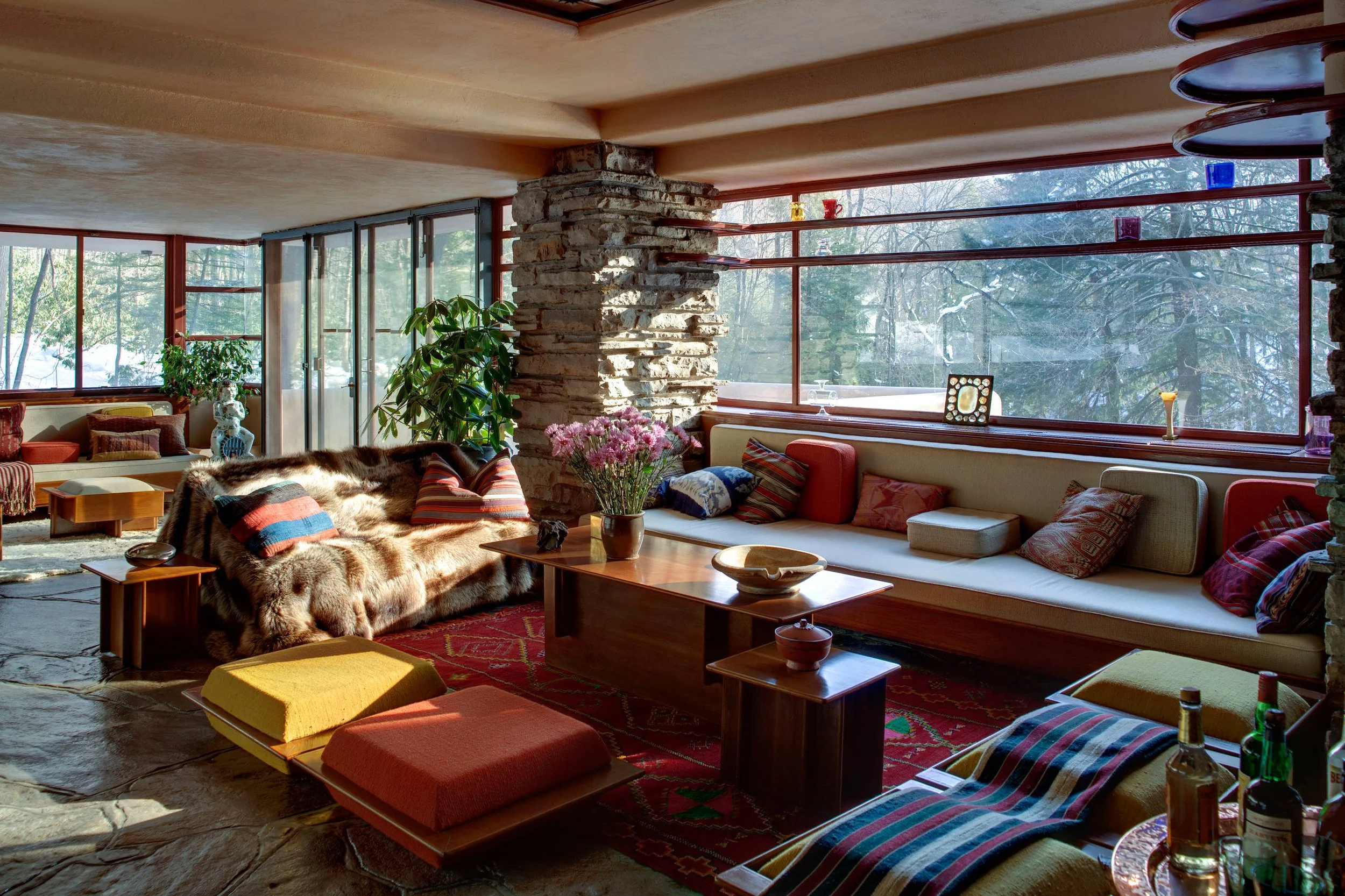Fallingwater: Frank Lloyd Wright’s Masterpiece That Floats Above the Forest
If the Stahl House is the icon of modern, elevated minimalism, then Fallingwater is the beating heart of organic architecture—a house so deeply rooted in its surroundings, it quite literally grows out of the rocks and streams beneath it.
As someone who’s a fan of Frank Lloyd Wright and a complete nerd for vintage design and architectural history, Fallingwater is one of those homes that feels almost mythical. I’ve yet to visit it in person (it’s definitely on the bucket list), but it’s the kind of structure you can study for hours and still feel like you’re missing something. It doesn’t just sit on a landscape—it becomes it.
So let’s dive into the incredible story of how Fallingwater came to be, why it’s so beloved, and the little-known details that make it one of the greatest homes ever built.
The Vision: A House Over a Waterfall
In the 1930s, department store magnate Edgar J. Kaufmann Sr. owned a weekend retreat in the forested hills of southwestern Pennsylvania. He wanted a modern vacation home for his family, and hired none other than Frank Lloyd Wright, who was then in his late 60s and had already become something of a legend (though his career was in a bit of a slump at the time).
But what Wright delivered was far more radical than anyone expected.
Kaufmann assumed the new home would offer a view of the beautiful waterfall on the property. Instead, Wright shocked him by proposing to build the house directly over the waterfall—so that the sound of rushing water would become part of the home’s heartbeat.
Wright reportedly waited until the last moment to draw the plans—famously sketching most of them in a single afternoon as Kaufmann was driving out to visit his studio. Talk about dramatic flair.
Nature and Architecture, Perfectly Intertwined
What makes Fallingwater so extraordinary is how it refuses to dominate nature. Instead, it flows with it—cantilevered decks mimic rock ledges, natural materials echo the landscape, and the house seems to float above the stream like a leaf on water.
Some key design elements:
Cantilevered Terraces: These iconic platforms stretch out from the central structure like stone shelves, hovering above the waterfall.
Natural Materials: The home is built from local sandstone and reinforced concrete, and Wright incorporated boulders directly into the foundation and even the living room.
Glass and Transparency: Glass walls and strip windows invite the forest inside, with panoramic views of trees, moss, and sky.
Wright called it “organic architecture”, and Fallingwater is its crown jewel.
Curious Details and Surprising Stories
The Soundtrack of the House Is the Waterfall: Wright intentionally made sure the house blocks the view of the falls from inside—so you’re not distracted by it visually, but you’re immersed in its sound.
The Fireplace Has a Boulder in It: One massive rock found on-site was too big to move—so Wright made it part of the living room floor and fireplace.
The Home Leaks… a Lot: Fallingwater was infamous for its constant water leaks, especially during rainstorms. Wright reportedly shrugged it off—he was more concerned with aesthetics than plumbing.
The Contractor Tried to “Fix” Wright’s Design: Fearing structural instability, the contractor added more steel than Wright originally called for. The house did eventually sag slightly over time—but it’s still standing today.
It Sparked a Career Revival for Wright: Fallingwater, built in 1935–39, catapulted Wright back into the spotlight. He was 67 when construction began, and went on to produce some of his greatest works in the decade that followed.
Why It Still Inspires in 2025
Fallingwater remains one of the most referenced houses in design and architecture today. Here's why:
It Proved Architecture Can Be an Extension of Nature
Not just nestled in nature, but of it. The house shows what happens when architecture becomes part of the landscape.
It Brought Modernism to Life Emotionally
Fallingwater isn’t cold or austere like many modernist buildings. It’s warm, moody, and rich with textures.
It’s Still Incredibly Relevant
Sustainability, biophilic design, organic materials—all these are trending now, but Wright did it 90 years ago.
It’s a True “Destination House”
Thousands of people visit it every year. You can’t live there, but seeing it is a pilgrimage for anyone who loves design.
Closing Thoughts
Fallingwater isn’t just a home—it’s a manifesto. It whispers instead of shouts. It teaches us that design doesn’t need to impose—it can collaborate. It can flow.
While my heart belongs to the glassy optimism of the Stahl House, there’s something almost spiritual about Fallingwater. It reminds us that a house can be more than a structure. It can be a living, breathing dialogue between place and person.
If you ever get the chance to visit in person, I envy you already.






